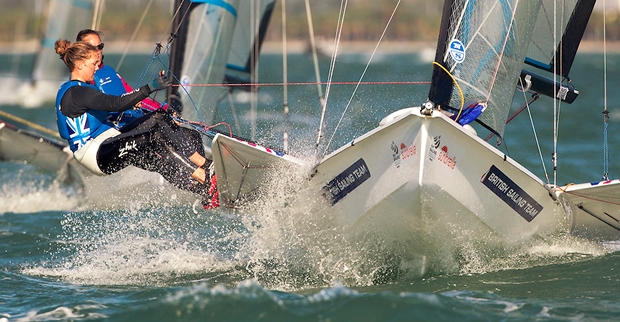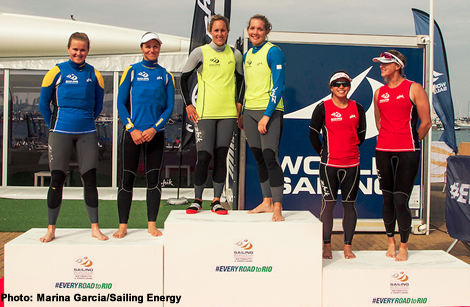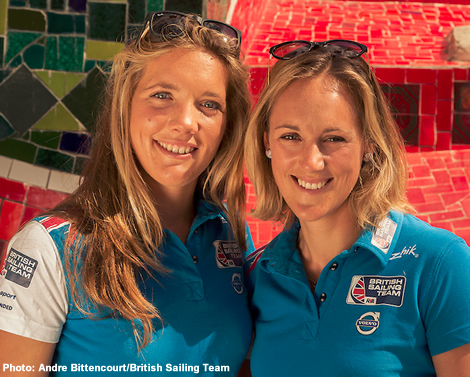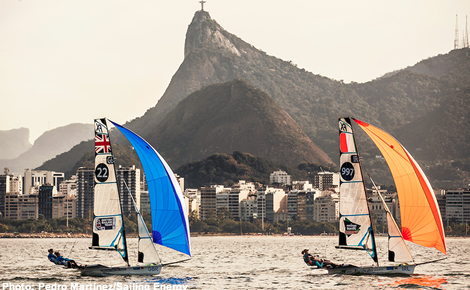
Fresh challenge - getting ahead in the 49erFX
A further lack of wind and an overcast sky over Weymouth Bay and Portland Harbour, alongside a forecast that indicated no improvement, created some down-heartedness on the penultimate morning of the Sailing World Cup Weymouth and Portland. While we did a Moth Worlds here once that was all but blown out for a full week, this is our first time here when there’s been too little wind; when at the end of the day three, only four races had been held in most classes.
Fortunately for sailors, race officials and the spectators who turned up to perch in deckchairs to watch racing on the big screen on the Weymouth and Portland National Sailing Academy hard, conditions did come good. By the afternoon race officials on all five courses were attempting to bang in the races to provide competitors with their money worth going into tomorrow’s final day medal races, limited, of course, to just the top 10 in each class.
One of the most jubilant crews to come off the water today were British 49erFX contenders, Charlotte Dobson and Sophie Ainsworth, for whom two bullets out of three races today has caused them to pull into the lead, going into tomorrow’s final medal race. Currently the Brits lie two points ahead of the Swedes, Julia Gross and Cecilia Jonsson and a further five ahead of world no3s from New Zealand, Alex Maloney and Molly Meech.
Coming ashore Dobson and Ainsworth both beaming. Dobson exclaimed: “I am really excited. Light winds have in the past has not been our thing. It’s been something we’ve been working really hard and it is amazing to see it come together as we hoped it would. And of course it is a very good time for it to come together too. The Swedish have always been good in those conditions and now we are beating them in some of those races.”
In fact in the final race, the Swedes were leading, but the Brits separated off to the left at the top of the second beat and, coming in on the port layline, just managed to sneak in front at the mark. “It was a case of joining the dots, backing up a bit on the runs and keeping your nerve in those painful light, ‘the boats moving-don’t breath’ moments,” said Ainsworth.
The light winds this week have also been good practice for Rio and learning how to switch off and not get stressed if racing gets cancelled. “We are practicing the routines we are expecting to do at the Olympics. We have played a lot of Cluedo with Nic [Groves] and Ben [Saxton], trying to keep your brain in gear, or listening to music.”
Dobson and Ainsworth came to the 49erFX pretty much from the word go. Ainsworth came from the 470 and had been training partner for Hannah Mills and Saskia Clark pre-London 2012, Dobson had been campaigning the Laser Radial for two cycles and having lost selection to London 2012 had all but thrown in the towel until her boyf – 49er helm Dylan Fletcher – took her for a sail on his skiff. “I literally had the best time ever, I felt like I was 15 again, sailing around. That coincided nicely with the FX coming, so I decided to give it a go.” Dobson returned to university over 2012-3 to continue her degree in Psychology and Economics, but when the FX was chosen at the end of 2012 and the first women's 49ers, with the shorter rig, hit the water the following year, she was part of the Team GBR squad.
At that point the squad comprised four helms and four crew who were rotated at regattas through the summer of 2013. However for Dobson and Ainsworth it was apparently the 49erFX equivalent of love at first sight. “We were clear that we wanted to sail together pretty much from the first day we went out together,” recalls Dobson. Fortunately the powers at the RYA saw it the same way.
In addition to playing helm-crew musical chairs, the first year was also used for getting the crews to work together. Dobson found this vital: “Coming from a singlehanded class and never having sailed a doublehanded boat in my life, I had to learn to how to stand up and speak at the same time! It was a good way of learning how to communicate with different types of people and finding out what my strengths and weaknesses were.”
It was inevitable that Dobson would helm – it’s all she’s ever done - while Ainsworth is, as Dobson puts it: “superfit and she felt a bit wasted in the 470. She is agile and wanted to jump around a bit more, so that role suited her.” In terms of which of them is the dominant personality, Dobson says they are quite balanced.
By the end of 2013, the 49erFX pairings were decided and it was down to three boats with Penny Clarke hanging up her seaboots and Catrina Hughes dropped out through injury – something that has affected FX crews much more than anyone anticipated.
As Dobson explains: “The whole fleet went through a lot of injuries - the FX requires you to be pretty robust. In fact there hasn’t been an obvious pathway for people to get into the FX. So I came from a sitting-down boat and my ankles weren’t strong enough to do all the running around. That is predominantly where the injuries have come from. Now our ankles and legs are more robust and the support staff is far better at preparing people before they start sailing the FX.”
Oddly the worst injuries haven’t happened in the sudden high speed crashes, but in the “slow, lame ones”. In the former you are typically catapulted safely out of the harm's way. Down speed you typically end up falling on a part of the boat. Or not falling...
Dobson injured her toe when her foot got caught in a foot loop leaving her dangling upside down, while Ainsworth suffered a neck injury due, it was subsequently found, to her shoulders not being strong enough and was instead using her neck muscles, as Dobson explains: “recruiting the wrong muscles to do stuff. Now she’s got the strongest neck in the world - she’s like a Formula 1 driver!” This put her out of action for almost four months going into the Test Event last year.
Dobson has also changed shape from her Radial days when she says she was always struggling to get big enough and to gain weight. “In the FX, a big element is being strong to pull yourself off the wire quickly against the G force of when you are turning. A lot of this cycle has been about creating the muscle movement patterns to be able to move well and be more agile, strong and robust enough to deal with capsizes and twists that cause your body to get into bizarre positions. Compared to the boys, the girls struggle with that more because they are so much more flexible, and you get yourself into odd positions that you’re potentially not strong enough to deal with.”
In terms of the ideal 49erFX size, the school remains out. According to Dobson at the start of this Olypmic cycle there were as much as 20kg of combined crew weight difference between teams. “The Argentinians were super small and would win everything when it was light and the Spanish would win everything when it was windy. Now I think everyone is coming together although there is quite a difference in heights of the different crews and helms so Alex [Moloney] and Annemiek [Bekkering] are super tiny helms, but have really tall crews. Soph and I are the same height and I think that is a good place for us to be: There is weight there when you need to hoist and drop and there is weight far back for when there’s breeze and you have to get to the back of the bus. But I don’t think anyone has the answer yet. There are many ways to skin the cat. In the 49er, most of the crews are within 4-5kg. For us, it takes a while for girls to put on muscles - it is like a four project.”
Looking back at their development over this cycle, 2014 was about boat handling. As Dobson puts it: “Getting it to the point where we weren’t capsizing and trying to get fast and work out what was going to be important with the rig and equipment.” The follow year was more focussing upon selection and “putting into practice a lot of the racing skills and working again on the boat handling side, to get that more proficient and to use that as a super strength rather than just getting by.”
After finishing fifth at the World Championship and in sight of the medals at several regattas, Dobson and Ainsworth got their ticket to Rio in March this year and, since then, their program has entirely focussed on bringing together all they have learned and preparing for the Games.
For coaching, they started with former 49er sailor Mark Asquith, but then turned to Moth champion Chris Rashley for 18 months to learn in detail about ‘the equipment’ while Asquith decamped to Canada. However they reverted to Asquith on his return. “Mark is really, really great at putting a nice spin on every day. He is a fun guy to be around and he puts everything in perspective, while being quite hard too. He has a strong 49er background and jumps in the boat with us every so often.”
Given that the 49erFX is a 49er with a chopped down rig, a significant amount could be learned from the 49er sailors. “It is important to recognise is that the rig is different and not try and just do exactly what the 49ers do. But in terms of the preparation of a skiff sailor and the style of racing, there is a lot of crossover and a lot to be learn. So whenever we can persuade the boys to let us come racing with them, then we try and tag on for as long as we can! Hopefully we do that more coming into the Games.”
Teams’ progress in the FX has been varied. Strong, straight out of the blocks, were the former 29er skiff sailors, especially the Danes and the Kiwis, but since then others have caught up. “I think now we are getting to the stage where we are racing properly in all conditions. 18 months ago, as soon as it was above 16 knots, it was a bit more about getting the boat around the course rather than racing. We are getting there in that respect. In our last World Championships there have been nine different medallists. 18 months ago there were one or two frontrunners, now everything has really compacted. It should be exciting - I think the form book will be pretty hard to call until the day before the start!”
Inevitably with a class in its infancy, crews remain slightly polarised about the conditions they are good in, hence why Dobson and Ainsworth have been so pleased with themselves for doing well in the light this week. “We are probably the most even across all the conditions to be honest,” admits Dobson. “For Rio that is a good thing to be.”
Dobson says that her Rio experience to date has been a great one. It helps that in her class is Martine Grael, the present World no1, who is part of the great Brazilian sailing dynasty. “With Martine, and her family, we were totally absorbed into the Brazilian lifestyle. It has always felt like a safe, friendly place with really nice people and we’ve always really loved sailing there. It has been a great place for the games.”
So she can samba now? “We did go to a samba party, but I’m not entirely convinced we could samba afterwards!”
She also likes the sailing there. For Rio 2016 there will be a number of different race areas, some inside the harbour, some outside. “It is fantastic because each race course has got its own personality. Outside, if it is windy, it will be more a boat handling type of race and the Sugar Loaf is a great race course with loads going on, really exciting. In fact that is my favourite race course. So there are real differences between each one so you have to be a bit of an all-round sailor.”
In fact with courses in the harbour and others outside, there are similarities to this week’s venue. However Rio’s topographical features are slightly more dramatic than the rolling Dorset hills. “It is a little bit more extreme than the Nothe, but is brilliant and I think it should be a really fun summer.”












Latest Comments
Add a comment - Members log in